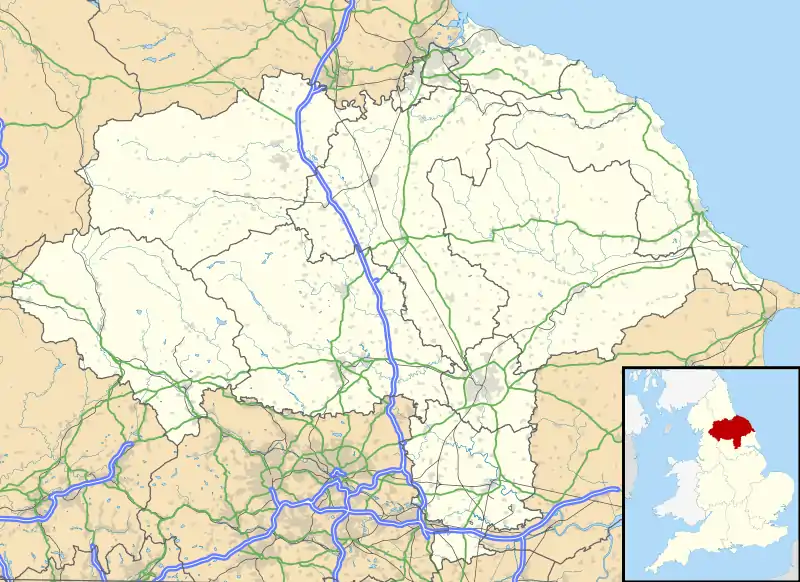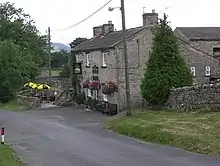Downholme
Downholme is a village and civil parish in the Richmondshire district of North Yorkshire, England. It is situated approximately 4 miles (6 km) west from the market town of Richmond and 16 miles (26 km) west from the county town of Northallerton. The village lies close to the edge of the Yorkshire Dales. The population as taken in the ONS Census of 2011 was less than 100, so details are included in the parish of Hudswell. In 2015, North Yorkshire County Council estimated the population of the village to be 50.[1]
| Downholme | |
|---|---|
 Village street in Downholme | |
 Downholme Location within North Yorkshire | |
| OS grid reference | SE111978 |
| • London | 210 mi (340 km) S |
| District | |
| Shire county | |
| Region | |
| Country | England |
| Sovereign state | United Kingdom |
| Post town | RICHMOND |
| Postcode district | DL11 |
| Police | North Yorkshire |
| Fire | North Yorkshire |
| Ambulance | Yorkshire |
| UK Parliament | |
History
The village is mentioned in the Domesday Book as "Dune" with the manor belonging to Count Alan of Brittany. The lordship of the manor was granted by the Count to Gospatric, son of Arnketil around the time of the Norman Conquest. There were two ploughlands with a taxable value of 3 geld units.[2] The manor came into the possession of Thomas de Richeburg before passing to the Leyburn family around 1184. Over the following years they granted the manor piecemeal to the abbey of St Agatha at Easby. The abbey then granted the manor lands to the Cleasby family by the middle of the 13th century. Around 1314, the Cleasby's passed the manor on to the Scrope family of Castle Bolton.[3][4]
The etymology of the name is derived from the Old English word dūn meaning hill. As can be seen from the Domesday Book entry, the suffix of -holme, Old English holegn for holly, was added a later date.[5][6]
Geography and governance

The village lies on the A6108 road between Leyburn and Richmond on a section called Walburn Head. The nearest settlements of Marske, Hudswell, Stainton and Marrick all lie within 2.5 miles (4 km) of the village. Church Gill, which has a small waterfall, runs north through the village to join the nearby River Swale, whilst other small waterways to the east of the village drain away to Risedale Beck. The village gives its name to the Moor between it and nearby Hudswell Moor. The high point is Seat How at 312 metres (1,024 ft) to the south-east of the village. There are visible signs of old quarries and coal and lead mining shafts on the hillsides surrounding the village. There is also evidence of a Bronze Age univallate hill fort on How Hill to the immediate west of the village.[7] The geology of the area is made of Yoredale rock, Limestone, Shale and Millstone Grit covered by Clay.[3][8]
The village lies within the Richmond (Yorks) UK Parliament constituency. It also lies within the Upper Dales electoral division of the North Yorkshire County Council and the Swaledale ward of Richmondshire District Council.[8]
In 2012, the neighbouring Hudswell Parish Council put forward a proposal to merge the two parishes.[9]
Demography

| Population[10] | ||||||||||||||||
|---|---|---|---|---|---|---|---|---|---|---|---|---|---|---|---|---|
| Year | 1801 | 1811 | 1821 | 1831 | 1841 | 1851 | 1881 | 1891 | 1901 | 1911 | 1921 | 1931 | 1951 | 1961 | ||
| Total | 193 | 325 | 204 | 174 | 192 | 202 | 112 | 732 | 93 | 66 | 76 | 74 | 77 | 65 | ||
For the 2001 and 2011 UK Censuses, the Parishes of Hudswell and Downholme were combined.[11]
Community
The village of Downholme has its own public house, the Bolton Arms, which first featured in the UK Good Pub Guide 2011 and in the current online edition.[12] The parish church to the north of the village, dedicated to St Michael and All Angels, is within the ecclesiastical parish of Downholme and Maske, in the Diocese of Ripon and Leeds.[13][14] Of Norman construction with a substantial restoration in 1886, it is a Grade II listed building.[4][15]
References
- "2015 Population Estimates Parishes" (PDF). northyorks.gov.uk. December 2016. p. 15. Retrieved 28 January 2020.
- Downholme in the Domesday Book. Retrieved 2 January 2014.
- "History". Retrieved 2 January 2014.
- Bulmer's Topography, History and Directory (Private and Commercial) of North Yorkshire 1890. S&N Publishing. 1890. pp. 420–421. ISBN 1-86150-299-0.
- Watts (2011). Cambridge Dictionary of English Place-names. Cambridge University Press. p. 193. ISBN 978-0521168557.
- A.D. Mills (1998). Dictionary of English Place-Names. Oxford Paperbacks. p. 160. ISBN 978-0192800749.
- Historic England. "Remains of Hill Fort (1012604)". National Heritage List for England. Retrieved 2 January 2014.
- Ordnance Survey Open Viewer"Archived copy". Archived from the original on 5 October 2012. Retrieved 14 October 2012.CS1 maint: archived copy as title (link) CS1 maint: bot: original URL status unknown (link)
- "Hudswell Parish Council Meeting May 2013" (PDF). p. 2. Retrieved 19 September 2017.
- "Population at Censuses". Vision of Britain. 2009. Retrieved 31 May 2013.
- "Hudswell Parish Statistics". Office for National Statistics. Retrieved 2 January 2014.
- "Bolton Arms". 2008–2014 The Good Pub Guide. Retrieved 2 January 2014.
- "Downholme: St Michael & All Angels". Archbishops' Council. Retrieved 2 January 2014.
- "Parish of Downholme and Marske" Archived 3 January 2014 at the Wayback Machine, The Diocese of Ripon and Leeds. Retrieved 2 January 2013
- Historic England. "Church of Saint Michael and All Angels (Grade II) (1179437)". National Heritage List for England. Retrieved 2 January 2014.
